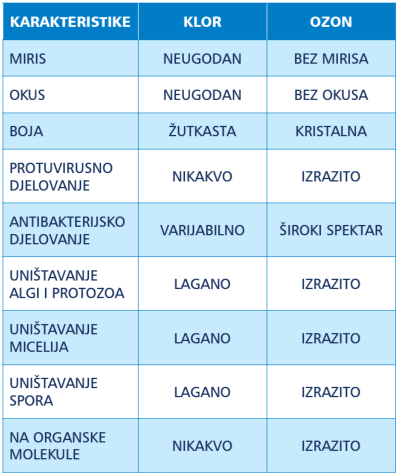About ozone
Ozone is generated electrically or by means of UV radiation, converting the diatomic oxygen molecules in the three-atom molecules. He is also known as the activated oxygen. Since ozone is an unstable gas, it is steady in a certain time period, after having performed its task it turns into oxygen.
Oxygen that is through photosynthesis created by plants and plankton, is raised to the upper layers of the atmosphere. There it absorbs UV radiation of the sun and the universe and turns it into ozone. This ozone is an integral part of the atmosphere.

Because it is heavier than oxygen, ozone descends into the lower layers of the atmosphere. In his declining it reacts with pollutants in the air which it comes into contact with and converts them into harmless compounds. If in its descent comes into contact with water vapor during a storm, it creates hydrogen peroxide H2O2, and with the rain it falls on the ground. For this reason, plants grow better when fed rainwater rather than irrigation. Ozone is therefore a natural agent that nature cleans the environment with. Ozone is the strongest natural oxidant.
Where is it used ?
Ozone is now widely used in industry for the disinfection of air and water. The purification of water is used since 1893., and in early 20th century was first used for food preservation.

It is used in:
• Health department
• Food industry
• Preparation of drinking water
• Hotels
• Pools
• Laundry
• Wastewater treatment
• Treatment of solid wastes
Ozone is antibacterial, anti-inflammatory, anti-parasitic, anti-tumor, antiviral and most importantly improves health. Its use in medical therapy has proven to be completely safe with no side effects and negative influences. In the medicine is used as a sterilizing agent for the prevention of nosocomial infections, and its use in medical therapy has proven to be quite safe as a substance which is capable of changing the balance of antioxidants and prooxidants in the body.
Why is it used?
• Since ozone is a natural gas composed of three atoms of oxygen O3 with highest oxidation power, up to 10 times greater than the chlorine-based products, there is a wide antimicrobial affect (against bacteria, viruses, fungi, and bacterial and fungal spores).
• Thanks to its high oxidizing power, ozone can disintegrate organic compounds.
• Ozone is a highly reactive molecule that shows excellent bactericidal, fungicidal and antiviral features. Unlike chlorine as an agent for the treatment of swimming pool and water, ozone does not form toxic compounds with organic molecules and does not lag behind in the water after sterilization:


• Ozone does not leave any marks, smells or tastes, either in the water or on surfaces that have come into contact with it, nor any of those which are out of natural origin such as, for example raw wood. Ozone can be used in the form of aqueous or gaseous, without the need of rinsing surface after treatment.
• Ozone is a powerful oxidizing agent and is able to degrade pollution into forms that are would normally decompose in nature.
Why is it worth?
Ozone is now widely used in industry for sterilization
Benefits of Ozone:
• Guarantees the inactivation of bacteria, mold, dust mites and viruses
• Disinfects hard to reach places
• It does not leave any marks or residues as either smells or tastes or in the water or in other organic surfaces
• Can be used as a gas or dissolved in water (no rinse)
• It does not use chemical agents
• It’s economical because it uses oxygen from the air
• Guarantees the microbiological safety of foods and longer shelf life
• Promotes the application of HACCP
• Eliminates the cost of chemical disinfectants
• Reduces energy consumption compared to the use of high temperature and steam
• Reduces water consumption and the cost of disposing of waste water
• Reduces emissions of harmful substances (ISO14000 , EI/IAS)
• Reduces labor costs
• If used in accordance with the instructions, there is no contraindication

